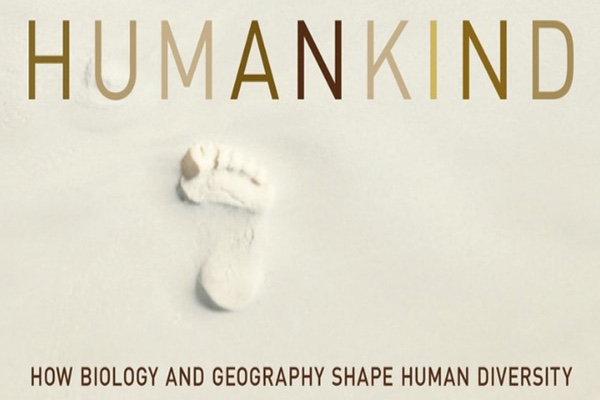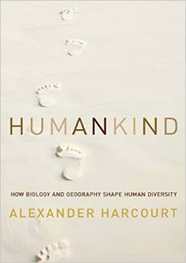How Would History Read Differently If We Treated Humans as Just Another Species?

The history of the human species is one of worldwide movement. We originated in Africa, maybe two hundred thousand years ago, and from sixty thousand years ago began to spread across the world in a diaspora that has not stopped to this day.
 We initially spread east, mainly along
tropical latitudes, as far as south-eastern Asia and Australia.
Subsequently we moved north into Siberia, even as the world cooled at
the approach of the last ice age. And then at the end of the ice-age,
perhaps sixteen thousand years ago, we entered the Americas. Less
than two thousand years later, we were in southern Chile.
We initially spread east, mainly along
tropical latitudes, as far as south-eastern Asia and Australia.
Subsequently we moved north into Siberia, even as the world cooled at
the approach of the last ice age. And then at the end of the ice-age,
perhaps sixteen thousand years ago, we entered the Americas. Less
than two thousand years later, we were in southern Chile.
Distant islands had to wait somewhat longer for our arrival. We first got to Hawaii maybe fifteen hundred years ago. But the Maoris did not reach New Zealand until seven hundred years ago. And they did not get there from Australia, but from the Cook Islands, over two thousand kilometers away.
Nowadays as war, killing and looting ravage homelands, and as some countries offer better opportunities than do homelands, hundreds of thousands of people are still on the move.
Sometimes the moving peoples were the ravagers. The Mongols might first come to mind. But brutal as they were, they seemed not to have eradicated any native populations. Indeed, genes on the male Y chromosome identified as originating from Mongolia are in eight percent of the peoples in and around the region that the Mongols conquered. In North America, the invaders, mostly Europeans (and of these, mostly Britons), pushed the Native Americans from east to west, until the remnants of a people that had covered the continent found themselves in reservations encompassing less then three percent of their former territory. Native Tasmanians suffered a worse fate. The invading British hunted, yes hunted, to extinction in less than a century the several cultures of the island.
As I have hinted, climate and geography affected these movements. For instance in China, periods of cold coincided with invasions from the north. In Eurasia, the Mongol invasion was aided, it seems, by a few decades of extraordinarily good weather. Not only that, but no major mountain ranges blocked their way.
All this is history, appropriately enough given this venue. But it is history only because I am writing about humans. Were I writing about all the other species that have done the same thing - expanded from where they originated, replaced other species where they went, went where the geography of the land allowed then to go - I would have been writing as a biogeographer. With humans, history is biogeography; biogeography is history.
Of course, the ‘bio’ part of biogeography adds considerations that might be rare in historical studies. As we spread from Africa, we changed. People with a new anatomy, a new physiology, survived, mated, and reproduced better in the novel environments that they entered and settled in.
Long, thin Africans evolved to be stocky, short-limbed Arctic peoples and high-altitude Andeans - because stocky bodies lose less heat than do long bodies. Dark skinned Africans evolved to be fair skinned Eurasians. In Africa we had evolved to obtain vitamin D, not from our diet, but from the action of sunlight on cells just under our skin. But the sun is pale for several months of the year at high latitudes, and pale-skinned people absorbed more sunlight than did dark-skinned people, and so were healthier.
The geography of these anatomical and physiological differences might not, strictly, be history, but of course the political and social consequences of the differences are very much part of history.
Diet is part of the environment, and we adapt to our diet too. We started keeping livestock maybe ten thousand years ago. What do livestock produce that the physical environment does not? Milk. Most people in the world lose the ability to digest milk when they are about three years old. Indeed, they get ill if they continue to drink milk. But herders in Europe and western Africa can continue into adulthood to digest it. They evolved the genetically based ability to continue into adulthood production of the enzyme that digests the milk sugar. Ten thousand years ago is getting close to what might be considered historical time.
Culture separates humans from animals: except in a grossly simple sense, animals do not have culture. Human cultures, then, must have developed through purely historical processes. No. With cultures we see some of the strongest influences of biology and geography on humans, some of the strongest biogeographic patterns among humans.
Ask a biogeographer to name - quick - a major geographical pattern among species. I wouldn’t mind betting that they would quickly come up with the mouthful, “the latitudinal gradient in species diversity.” By that they mean the tropics are diverse in number of species; higher latitudes are relatively impoverished. Ecuador has over 20,000 species of plant; Britain has less than 2000. A biologist, George Forster, on one of Captain Cook’s voyages was one of the first to notice this gradient. In his honor I call it the Forster effect.
Humans cultures show the Forster effect.; Ecuador has 23 identifiable languages; Britain has 12. Tropical South America has 487 languages; the USA has 176. The contrast is repeated across the world. Africa, three times the size of Europe, has nine times the number of languages, 2100 as against 230.
Among non-human species, plants as well as animals, the Forster effect comes with a latitudinal contrast in size of geographic range. Tropical species average smaller ranges than do high-latitude species. The human species is no exception. We too show this so-called Rapoport effect. Tropical cultures cover a few thousand square kilometers; arctic ones some tens of thousands.
Why the difference? The year-round productive tropics can support a population large enough to persist in a far smaller area than can higher latitudes, where the growing season can be less than six months long.
Note that in this previous paragraph I have made no mention of the species involved. I do not have to. We humans are a carbon-based life form, like all other species. Hence we experience the same biological and geographic influences on our distribution as do other species. We are just another species.
Our geography determines our biology. Our biology determines our geography. Our geography determines our history. Our history determines our geography. With humans, history is biogeography; biogeography is history.